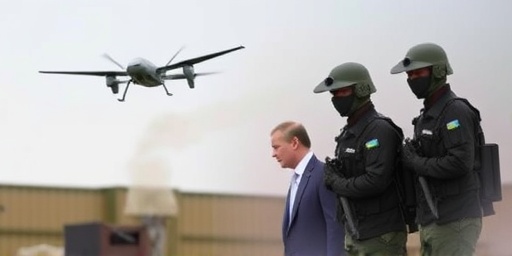In a dramatic escalation of diplomatic pressure, the United States has urged Ukraine to accept a sweeping 28-point peace plan that demands significant territorial concessions and sharp reductions in its military capabilities, even as Russia ramps up its barrage of drone and missile attacks on Ukrainian cities. This move, revealed through high-level sources in Washington, comes at a precarious moment in the ongoing conflict, with Ukrainian President Volodymyr Zelenskyy facing mounting internal and external calls to negotiate amid battlefield setbacks.
The proposal, hammered out in secretive talks involving US officials and select Ukrainian representatives, outlines a framework that would see Ukraine cede control over Crimea and parts of the Donbas region—territories long claimed by Moscow. It also calls for demilitarization zones along the border, limits on Ukraine‘s NATO aspirations, and a cap on its armed forces at 150,000 troops, down from current estimates of over 700,000 active personnel. Proponents argue this could end the war that’s ravaged Europe since Russia’s full-scale invasion in February 2022, but critics decry it as a betrayal of Ukrainian sovereignty.
Breaking Down the 28-Point US Peace Plan’s Demands
The US peace plan, dubbed internally as the “Kyiv Accord Framework,” spans 28 detailed points designed to address security, territorial, and humanitarian issues. At its core, point 1 explicitly recognizes Russia’s annexation of Crimea, formalized in a 2014 referendum widely condemned as illegitimate by the international community. Points 4 through 8 propose a frozen conflict line along the current front, effectively granting Russia de facto control over roughly 18% of Ukraine’s pre-2014 territory, including key industrial hubs in Luhansk and Donetsk oblasts.
Military concessions form the backbone of points 9 to 15. Ukraine would be required to dismantle heavy weaponry within 50 kilometers of the border, including artillery and rocket systems that have been pivotal in its defense against Russian advances. The plan mandates a 50% reduction in Ukraine’s defense budget over five years, redirecting funds toward reconstruction efforts estimated at $500 billion by the World Bank. “This isn’t capitulation; it’s pragmatism,” a senior US State Department official told reporters on condition of anonymity. “We’ve modeled this on successful post-conflict resolutions like the Dayton Accords in Bosnia.”
Humanitarian aspects, covered in points 16 to 22, include provisions for prisoner exchanges—potentially freeing thousands of captives on both sides—and safe corridors for civilian evacuations from war-torn areas like Kharkiv and Kherson. Economic incentives are dangled in points 23 to 28, with promises of $100 billion in US-led aid for rebuilding infrastructure, contingent on Ukraine’s compliance. However, the plan’s exclusion of sanctions relief for Russia unless verified troop withdrawals occur has irked Moscow, which dismissed it as “one-sided meddling” through state media.
Statistics underscore the plan’s urgency: Over 10 million Ukrainians have been displaced since the invasion, according to UN data, while economic losses exceed $400 billion. The proposal aims to halt this hemorrhage, but Ukrainian diplomats leaked details suggest Zelenskyy’s team views the territorial demands as non-starters, fearing they would embolden further Russian aggression.
Russia’s Renewed Offensive: Drones and Missiles Target Ukrainian Heartland
As Washington pushes its peace agenda, Russia has unleashed a ferocious wave of attacks, deploying over 200 drones and 50 missiles in the past 72 hours alone, according to Ukraine’s Air Force Command. Strikes have hammered energy infrastructure in Kyiv and Odesa, leaving hundreds of thousands without power amid winter’s chill. In Zaporizhzhia, a missile barrage on a residential building killed 12 civilians and injured 35, marking one of the deadliest incidents this month.
These assaults appear timed to undermine negotiations, with Russian President Vladimir Putin signaling through Kremlin spokespeople that any peace must align with Moscow’s “red lines,” including full recognition of annexed territories. Satellite imagery from Maxar Technologies shows Russian forces massing near Avdiivka, a Donbas stronghold, with troop numbers swelling to 40,000—up 20% from last week. Ukrainian defenses, bolstered by Western-supplied Patriot systems, intercepted 85% of incoming threats, but officials warn of dwindling interceptor stocks.
“Every drone that slips through is a reminder of Russia’s unwillingness to negotiate in good faith,” said Ukrainian Foreign Minister Dmytro Kuleba in a televised address. The attacks have exacerbated a humanitarian crisis, with UNICEF reporting that 4.7 million children in Ukraine face acute risks from disrupted schooling and food shortages. Russia’s strategy, analysts say, is to inflict maximum pain to force Ukraine to the table on Moscow’s terms, complicating the US peace plan’s rollout.
European Leaders Rally Against US-Led Exclusion from Peace Talks
European leaders, sidelined from the initial drafting of the US peace plan, have erupted in criticism, accusing the Biden administration of bypassing allies in a bid for unilateral influence over the war’s endgame. German Chancellor Olaf Scholz, in a pointed speech to the Bundestag, decried the “transatlantic disconnect,” noting that Berlin—Ukraine’s second-largest donor with €17 billion in aid—learned of the plan’s contours only through media leaks.
French President Emmanuel Macron echoed these sentiments during a joint press conference with UK Prime Minister Rishi Sunak in Paris. “Europe cannot be a spectator in decisions affecting our security,” Macron stated, emphasizing that the EU’s €100 billion support package for Ukraine since 2022 entitles it to a seat at the table. Polish President Andrzej Duda went further, warning that the plan’s territorial concessions could destabilize NATO’s eastern flank, potentially inviting Russian incursions into the Baltics.
The exclusion stems from the Biden administration’s desire for speed, sources say, amid US domestic pressures like the upcoming 2024 elections. Yet, this has strained alliances: A leaked EU diplomatic cable obtained by Reuters reveals concerns that the US peace plan undermines the G7’s unified stance on Ukraine’s territorial integrity. In response, European leaders are convening an emergency summit in Brussels next week to formulate a counter-proposal, focusing on stronger security guarantees without ceding land.
Public opinion in Europe reflects this unease. A recent Eurobarometer poll shows 62% of respondents in Germany and France favor continued arming of Ukraine, but support drops to 45% if it means prolonged conflict without clear diplomatic paths. The rift highlights broader tensions in transatlantic relations, with European leaders pushing for a more inclusive “European Security Architecture” to replace the US-centric approach.
Biden Administration Stands Firm: Peace Plan as the Sole Viable Exit
Defending the initiative amid backlash, the Biden administration portrays the US peace plan as a bold, necessary step toward de-escalation. National Security Advisor Jake Sullivan, in an exclusive interview with CNN, argued that “prolonging the war serves no one’s interests—least of all Ukraine’s brave people.” He highlighted intelligence assessments showing Russian forces could sustain operations for another 18-24 months, potentially leading to further Ukrainian losses of up to 100,000 troops.
White House Press Secretary Karine Jean-Pierre reinforced this during daily briefings, stating, “This 28-point framework is the only realistic path to ending the bloodshed, preserving lives, and securing a stable Europe.” The administration points to quiet endorsements from some Ukrainian oligarchs and military figures weary of the stalemate, though public support remains elusive. Polls by the Kyiv International Institute of Sociology indicate only 28% of Ukrainians would accept territorial compromises, down from 35% last year.
Behind the scenes, US envoys have intensified shuttle diplomacy, meeting Zelenskyy in Lviv last week to present economic carrots alongside the sticks. The plan’s viability hinges on Russian buy-in, but Putin’s recent speeches suggest Moscow views it as a starting point for more expansive demands, including Ukraine’s permanent neutrality. Critics within the US, including Republican senators like Lindsey Graham, have slammed the proposal as “appeasement,” urging instead for unrestricted aid to Ukraine.
The Biden team’s calculations are rooted in global shifts: With China’s tacit support for Russia and Iran’s drone supplies bolstering Moscow’s arsenal, Washington sees negotiation as a way to refocus on Indo-Pacific threats. Yet, implementation challenges loom large—verification mechanisms for demilitarization could require UN peacekeeping forces, a prospect opposed by both Kyiv and Moscow.
Looking ahead, the US peace plan’s fate will likely be tested in upcoming multilateral forums, such as the NATO summit in Vilnius extensions or UN General Assembly sessions. If Ukraine balks, the Biden administration may withhold portions of the $61 billion aid package approved in April, pressuring Zelenskyy to engage. For Europe, mending fences with Washington while asserting its role could redefine alliance dynamics. Meanwhile, as Russian attacks persist, the human cost mounts, with over 500,000 total casualties estimated by Western intelligence—underscoring that time is not on anyone’s side in this protracted struggle.









